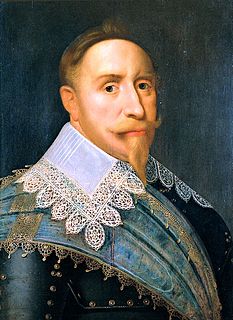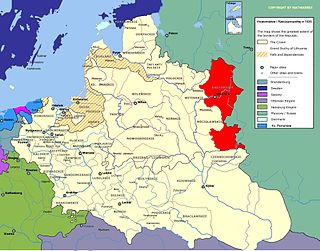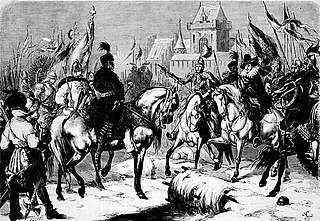 W
WThe Great Northern War (1700–1721) was a conflict in which a coalition led by the Tsardom of Russia successfully contested the supremacy of the Swedish Empire in Northern, Central and Eastern Europe. The initial leaders of the anti-Swedish alliance were Peter I of Russia, Frederick IV of Denmark–Norway and Augustus II the Strong of Saxony–Poland–Lithuania. Frederick IV and Augustus II were defeated by Sweden, under Charles XII, and forced out of the alliance in 1700 and 1706 respectively, but rejoined it in 1709 after the defeat of Charles XII at the Battle of Poltava. George I of Great Britain and the Electorate of Hanover joined the coalition in 1714 for Hanover and in 1717 for Britain, and Frederick William I of Brandenburg-Prussia joined it in 1715.
 W
WPolish-Cossack-Tatar War was the war between the Polish–Lithuanian Commonwealth and the Ottoman Empire over Ukraine. It was one of the aftermaths of the Russo-Polish War (1654–1667) and a prelude to the Polish–Ottoman War (1672–1676).
 W
WThe Polish–Muscovite War, also known as the Polish–Russian War of 1605–1618 or the Dimitriads, was a conflict fought between the Tsardom of Russia and the Polish–Lithuanian Commonwealth from 1605 to 1618.
 W
WThe Polish–Swedish War (1600–1611) was a continuation of struggle between Sweden and the Polish–Lithuanian Commonwealth over control of Livonia and Estonia, as well as the dispute over the Swedish throne between Charles IX of Sweden and Sigismund III of Poland.
 W
WThe Polish–Swedish War (1617–18) was a phase of the longer Polish–Swedish War (1600–29). It continued the war of 1600–11 and was an attempt by Sweden to take Polish pressure off Russia. The Polish–Lithuanian Commonwealth was then also fighting Tartars and the Ottoman Empire. Russia and Sweden were at that stage allied, prior to the Ingrian War, part of Russia's Time of Troubles. The 1617–18 war's cause was a dispute over Livonia and Estonia, and a dispute between Sigismund III Vasa and Gustavus Adolphus over the Swedish throne.
 W
WThe Polish–Swedish War of 1621 to 1625 was a war in a long-running series of conflicts between the Polish–Lithuanian Commonwealth and the Swedish Empire. It began with a Swedish invasion of the Polish–Lithuanian fiefdom Livonia. Swedish forces succeeded in taking the city of Riga after a siege. The Commonwealth, focussed on war with the Ottoman Empire, was unable to send significant forces to stop Gustav Adolf, and signed a truce favorable to Sweden. The Commonwealth ceded Livonia north of the Dvina (Düna) river, and retained only nominal control over Riga. The new truce in Mitau was signed and lasted from November 1622 to March 1625.
 W
WThe Russo-Polish War of 1654–1667, also called the Thirteen Years' War, First Northern War, War for Ukraine or Russian Deluge, was a major conflict between the Tsardom of Russia and the Polish–Lithuanian Commonwealth. Between 1655 and 1660, the Swedish invasion was also fought in the Polish–Lithuanian Commonwealth and so the period became known in Poland as "The Deluge" or Swedish Deluge. Because of this, it is sometimes referred as Russo–Swedish Deluge.
 W
WThe Second Northern War was fought between Sweden and its adversaries the Polish–Lithuanian Commonwealth (1655–60), the Moscow Tsardom (1656–58), Brandenburg-Prussia (1657–60), the Habsburg Monarchy (1657–60) and Denmark–Norway. The Dutch Republic often intervened against Sweden in an informal trade war but was not a recognized part of the Polish–Danish alliance.
 W
WThe Smolensk War (1632–1634) was a conflict fought between the Polish–Lithuanian Commonwealth and Russia.
 W
WThe War of the Polish Succession was a major European conflict sparked by a Polish civil war over the succession to Augustus II of Poland, which the other European powers widened in pursuit of their own national interests. France and Spain, the two Bourbon powers, attempted to test the power of the Austrian Habsburgs in western Europe, as did the Kingdom of Prussia, whilst Saxony and Russia mobilized to support the eventual Polish victor. The fighting in Poland resulted in the accession of Augustus III, who in addition to Russia and Saxony, was politically supported by the Habsburgs.
 W
WThe War of the Polish Succession or the Habsburg-Polish War took place from 1587 to 1588 over the election of the successor to the King of Poland and Grand Duke of Lithuania Stephen Báthory. The war was fought between factions of Sigismund III Vasa and Maximilian III, with Sigismund eventually being crowned King of Poland and Grand Duke of Lithuania. Two major battles of this conflict included the Siege of Kraków, in which Maximilian III failed to capture the capital of the Commonwealth, and the Battle of Byczyna, in which Maximilian was forced to surrender. Sigismund's victory was significantly the doing of Chancellor and Hetman Jan Zamoyski, who stood behind both the political intrigue and the military victories of this conflict.